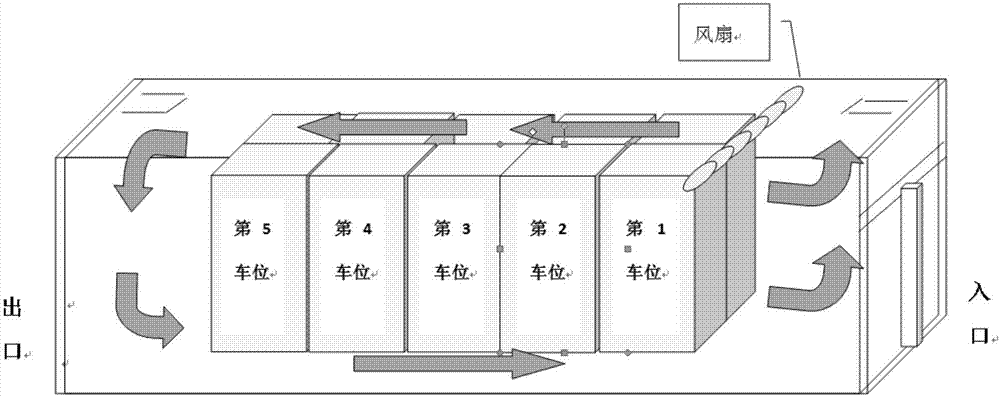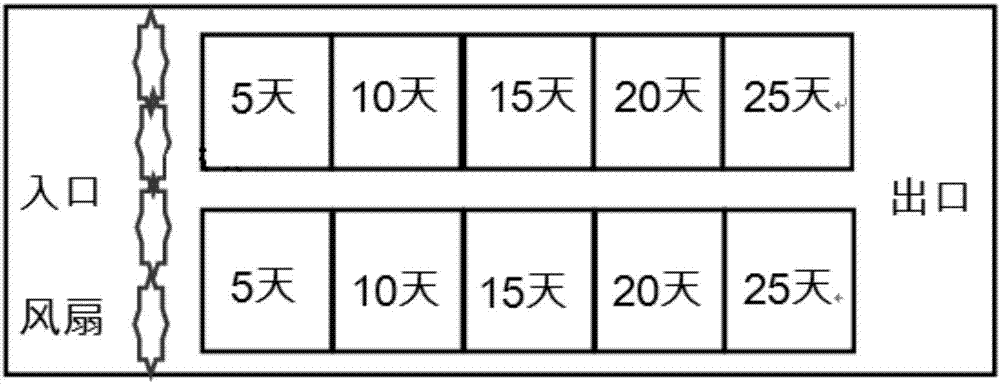Novel process for improving duck egg hatching achievement in roadway hatching machine
A tunnel and duck egg technology, applied in the field of tunnel incubators, can solve problems such as poor hatching duck eggs, and achieve the effects of avoiding high egg surface temperature, improving hatching performance, and reducing rotten eggs.
- Summary
- Abstract
- Description
- Claims
- Application Information
AI Technical Summary
Problems solved by technology
Method used
Image
Examples
Embodiment 1
[0044] A new technique for improving the hatching performance of duck eggs in a roadway incubator, comprising the following steps:
[0045] Step 1: When the duck eggs are hatched for about 25 days, the incubator in the fifth parking space pulls out the incubator, transfers to the hatcher, and performs the operation of transferring eggs on the tray. The incubation time of each parking space is as follows: Figure 4 shown;
[0046] Step 2: Push the new hatch car from the entrance to the first parking space. There are hatch cars in the other 4 parking spaces, and the operation of hatching new eggs is performed. The incubation time of each parking space is as follows: Figure 5 shown;
[0047] Step 3: After step 2 is finished, pull out the incubator car in the fifth parking space from the exit, perform egg candling operation, and remove non-fertilized eggs, cracked eggs and dead embryonated eggs. After the operation is completed, push the incubator from the entrance to the posit...
Embodiment 2
[0049] A new technique for improving the hatching performance of duck eggs in a roadway incubator, comprising the following steps:
[0050] Step 1: When the duck eggs are hatched for about 25 days, the incubator in the fifth parking space pulls out the incubator, transfers to the hatcher, and performs the operation of transferring eggs on the tray. The incubation time of each parking space is as follows: Figure 4 shown;
[0051] Step 2: Push the new hatch car from the entrance to the first parking space. There are hatch cars in the other 4 parking spaces, and the operation of hatching new eggs is performed. The incubation time of each parking space is as follows: Figure 5 shown;
[0052]Step 3: After step 2 is finished, pull out the incubator car in the fifth parking space from the exit, perform egg candling operation, and remove non-fertilized eggs, cracked eggs and dead embryonated eggs. After the operation is completed, push the incubator from the entrance to the positi...
Embodiment 3
[0055] A new technique for improving the hatching performance of duck eggs in a roadway incubator, comprising the following steps:
[0056] Step 1: When the duck eggs are hatched for about 25 days, the incubator in the fifth parking space pulls out the incubator, transfers to the hatcher, and performs the operation of transferring eggs on the tray. The incubation time of each parking space is as follows: Figure 4 shown;
[0057] Step 2: Push the new hatch car from the entrance to the first parking space. There are hatch cars in the other 4 parking spaces, and the operation of hatching new eggs is performed. The incubation time of each parking space is as follows: Figure 5 shown;
[0058] Step 3: After step 2 is finished, pull out the incubator car in the fifth parking space from the exit, perform egg candling operation, and remove non-fertilized eggs, cracked eggs and dead embryonated eggs. After the operation is completed, push the incubator from the entrance to the posit...
PUM
 Login to View More
Login to View More Abstract
Description
Claims
Application Information
 Login to View More
Login to View More - R&D
- Intellectual Property
- Life Sciences
- Materials
- Tech Scout
- Unparalleled Data Quality
- Higher Quality Content
- 60% Fewer Hallucinations
Browse by: Latest US Patents, China's latest patents, Technical Efficacy Thesaurus, Application Domain, Technology Topic, Popular Technical Reports.
© 2025 PatSnap. All rights reserved.Legal|Privacy policy|Modern Slavery Act Transparency Statement|Sitemap|About US| Contact US: help@patsnap.com



